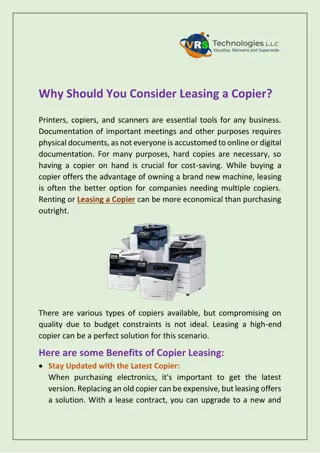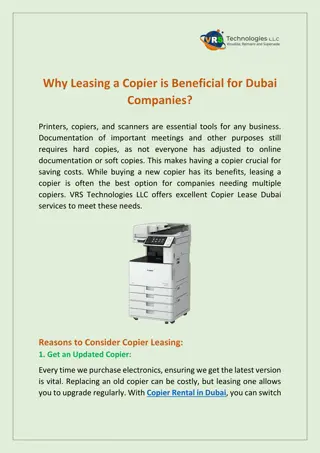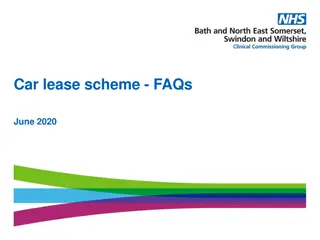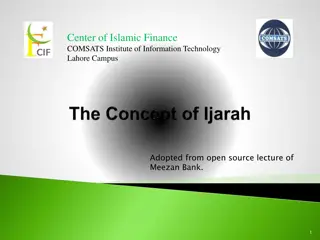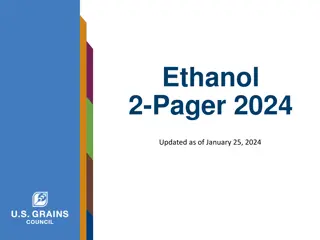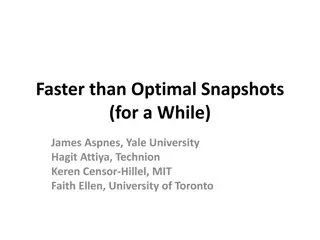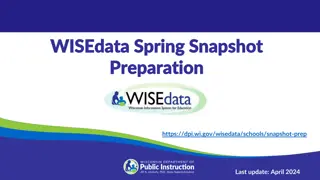October 2019 Equipment Leasing & Finance Industry Snapshot
The October 2019 Equipment Leasing & Finance Industry Snapshot provides insights into the current state of the economy, focusing on GDP growth, consumer spending, global manufacturing slowdown, and business optimism. Despite economic headwinds such as the global manufacturing slowdown and waning business optimism, there are positive tailwinds like low consumer financial stress and robust consumer spending. Additional factors to watch include strained U.S.-China relations, potential housing market improvement, and the employment outlook amid slowing job growth.
Download Presentation

Please find below an Image/Link to download the presentation.
The content on the website is provided AS IS for your information and personal use only. It may not be sold, licensed, or shared on other websites without obtaining consent from the author.If you encounter any issues during the download, it is possible that the publisher has removed the file from their server.
You are allowed to download the files provided on this website for personal or commercial use, subject to the condition that they are used lawfully. All files are the property of their respective owners.
The content on the website is provided AS IS for your information and personal use only. It may not be sold, licensed, or shared on other websites without obtaining consent from the author.
E N D
Presentation Transcript
October 2019 Equipment Leasing & Finance Industry Snapshot
Data: Table of Contents 1. Overall Economy p. 3 2. Investment p. 8 3. Business Health p. 11 2
Economy GDP growth eased to 2.0% in the second quarter, mirroring weakening economic fundamentals amid rising uncertainty. Real GDP Growth Annualized Percent Change from Previous Quarter 5% 4% 3.5% 3.5% 3.2% 3.1% 3.0% 2.9% 30-Year Quarterly Average = 2.5% 3% 2.6% +2.0% 2.3% 2.2% 2.2% 2.0% 2.0% 1.9% 2% 1.3% 1.1% 1% 0.1% 0% 2015.Q2 2016.Q2 2017.Q2 2018.Q2 2019.Q2 3 Source: U.S. Bureau of Economic Analysis, Keybridge LLC
Economy Growth was driven primarily by consumer spending in Q2, while investment and net exports dragged on the U.S. economy. Tailwinds & Headwinds Contributions to GDP Growth by Sector 4 Source: U.S. Bureau of Economic Analysis, Keybridge LLC
Top Economic Headwinds & Tailwinds ECONOMIC TAILWINDS Despite being late in the current business cycle, consumers exhibit low financial stress, as charge-off and delinquency rates for all loans remain exceptionally low. While certain corners of the consumer credit market are showing signs of stress, consumers appear well-positioned to continue managing debt effectively. Low Consumer Financial Stress Consumer spending bounced back in Q2 growing 4.6% on an annualized basis in real terms after weak Q1 growth. While it is unlikely consumers will maintain this strong spending pace, there are few signs of a pronounced slowdown or near-term recession. Robust Consumer Spending ECONOMIC HEADWINDS Global manufacturing activity has suffered due to slowing global growth and escalating trade tensions between the United States and China. Manufacturing in the United States, China, and Europe have slowed significantly as demand wanes, and is unlikely to recover in 2019. Global Manufacturing Slowdown Economic uncertainty has spread throughout the global economy, severely weighing on U.S. business confidence. U.S. small businesses are more upbeat but are showing signs of concern; a trend that could portend the end of the current business cycle if it continues. Waning Business Optimism 5 Source: Q4 2019 Equipment Leasing & Finance U.S. Economic Outlook
Additional Factors to Watch Relations between the United States and China remain strained, as what has started as a trade war has transformed into strategic engagement on multiple fronts. 1 China Relations? Even if the U.S. decides it wants a trade deal in the near term, it is unlikely to reduce tension in areas beyond trade. While the housing market has been sluggish over the past two years, recent data suggest there is potential for a modest improvement. Housing Market Improvement? 2 Although housing input costs are elevated and have weighed on housing affordability, housing activity picked up amid sub-4% mortgage rates. The labor market has been the growth engine for the U.S. economy, as U.S. employers have added to their payrolls for nearly 110 months. Employment Outlook? 3 However, job growth has slowed markedly in 2019, particularly in manufacturing and construction, and is unlikely to accelerate and may slow further. The past year has been particularly volatile for U.S. financial markets, reflecting geopolitical and economic uncertainty, and a sharp decline could cause a pullback in consumer spending. Equity Market Turmoil? 4 However, there is evidence that global investors see U.S. markets as a safe haven, which could foster the bull market s continuation. 6 Source: Q4 2019 Equipment Leasing & Finance U.S. Economic Outlook
Projections for Key Economic Indicators 2019 Quarterly Estimates Indicator 2017 2018 2019e Q1e Q2e Q3e Q4e 3.1% 2.0% 1.6% 1.8% 2.2% 2.4% 2.9% Real GDP (SAAR %) Real Investment in Equipment & Software (SAAR %) 3.5% 2.1% 1.7% 1.5% 3.9% 5.5% 7.7% Inflation (year-on-year %) 1.6% 1.9% 1.7% 1.8% 1.8% 2.1% 2.4% Federal Funds Target Rate (upper bound, end of period) 2.5% 2.5% 2.00% 1.75% 1.75% 1.5% 2.5% 10-year Treasury Rate (end of period) 2.40% 2.00% 1.68% 1.35% 1.45% 2.40% 2.70% Total Payroll Growth (thousands) +521 +456 +470 +425 +1872 +2153 +2679 Source: Q4 2019 Equipment Leasing & Finance U.S. Economic Outlook 7
Investment Business investment contracted in Q2 for the first time since early 2016. Business Investment Real Nonresidential Fixed Investment, Percent Change from Previous Quarter (SAAR) 30% 20% 10% -1.0% 0% -10% -20% Q2.2009 Q2.2010 Q2.2011 Q2.2012 Q2.2013 Q2.2014 Q2.2015 Q2.2016 Q2.2017 Q2.2018 Q2.2019 Source: U.S. Bureau of Economic Analysis 8
Investment Equipment investment growth should remain weak over the remainder of the year, but momentum has improved somewhat since the Q3 Snapshot. Equipment & Software Investment Momentum Monitor (Equipment Vertical Performance Matrix) Source: Q4 2019 Equipment Leasing & Finance U.S. Economic Outlook For more information on how to use the Momentum Monitors, see final slide. 9
Investment Equipment and software investment is projected to expand by a modest 3.9% in 2019. Real Equipment & Software Investment Growth Q/Q Percent Change, SAAR 20% Forecasts 15% 11.2% 9.2% 10% 8.2% 8.0% 7.5% 7.0% 5.0% 4.2% 5% 3.5% 2.1% 2.1% 1.8% 1.7% 1.5% 0% -0.2% -0.2% -2.0% -5% -10% -15% 2015.Q4 2016.Q4 2017.Q4 2018.Q4 2019.Q4 Source: U.S. Bureau of Economic Analysis; Projections from Keybridge 10
Bus. Health New business volume growth in 2019 is on track to beat 2018 levels after recovering from a slow first half of the year. MLFI-25 New Business Volume Through August*, investment is up 3.4% relative to year-ago levels Billion Dollars $120 $107.1 $100 $103.6 $99.5 $97.4 $96.7 $95.1 $89.0 $80 $84.6 $74.0 $60 $60.6 $54.3 $40 $20 $0 2009 2010 2011 2012 2013 2014 2015 2016 2017 2018 2019 *2019 data through August projected through end of year using a simple year-to-date extrapolation. Source: ELFA MLFI-25 11
Bus. Health In August, new business volume grew at a modest 3.4% yearly pace, slowing down significantly from growth in April through July. MLFI-25 New Business Volume Y/Y Percent Change 40% 30% 20% 10% 0% 3.4% -10% -20% -30% 12 Source: ELFA MLFI-25
Bus. Health Additionally, the Monthly Confidence Index dropped 4.2 points to 54.7 in September, suggesting the industry outlook is deteriorating. Monthly Confidence Index: Equipment Finance Industry (MCI-EFI) 80 70 60 54.7 50 40 30 2012 2013 2014 2015 2016 2017 2018 2019 Source: ELFF MCI-EFI 13
Bus. Health The PayNet Small Business Lending Index dropped 5.3 points in August, pointing to potentially weaker lending activity. PayNet Small Business Lending Index (SBLI) January 2005 = 100 160 SBLI 135 142.2 SBLI 3MMA 110 85 60 2009 2010 2011 2012 2013 2014 2015 2016 2017 2018 2019 Source: PayNet 14
EQUIPMENT LEASING & FINANCE FOUNDATION For more information on how you can use this information in your business, download the recently-updated Applied Economics Handbook. Reports are available to download at www.store.leasefoundation.org 15
Notes *U.S. Equipment & Software Investment Momentum Monitor (Slide 9) Published monthly, the U.S. Equipment & Software Investment Momentum Monitor is a set of leading indicators for the equipment sector consisting of indices for various equipment and software investment verticals. These indices are designed to identify turning points in their respective investment cycles with a 3 6 month lead time. Each index is comprised of between 15 to 20 high-frequency indicators and is statistically optimized to signal turning points in the investment cycle without giving false readings of shifts in momentum. The Momentum Monitor covers 12 equipment and software verticals as defined by the U.S. Department of Commerce Bureau of Economic Analysis. These verticals include aircraft, agriculture machinery, computers, construction machinery, materials handling equipment, medical equipment, mining and oilfield equipment, other industrial equipment, railroad equipment, ships and boats, software, and trucks. Recent Momentum" represents the degree of an indicator's recent acceleration or deceleration in the past month relative to its average movement during the previous 3 months. Ratings closer to "0" represent an indicator that is rapidly decelerating, while ratings closer to 10 represent an indicator that is rapidly accelerating. "Historical Strength" represents the strength or weakness of an indicator in the past month relative to its typical level since 1999. Ratings closer to "0" represent an indicator that is weaker than average, while ratings closer to "10" represent an indicator that is stronger than average. 16








